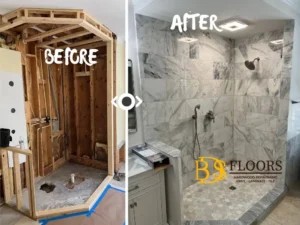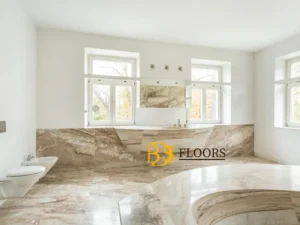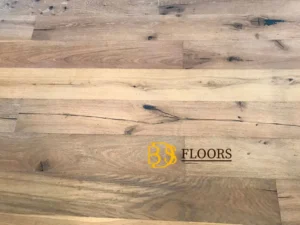Floor polishing, buffing, waxing, and refinishing are distinct methods for revitalizing floors that have lost their shine or have become scratched or dull. These techniques involve removing dirt and grime and rejuvenating the protective topcoat of the floor. Although people may use these terms interchangeably or consider them to be the same thing, each process is specific to certain types of flooring. This article will describe each process, indicate which one is appropriate for each type of floor, and suggest whether it is best to undertake the job oneself or hire a professional. At the end of the article, we have provided a list of different flooring types, along with information about how to restore their shine.
To Summarize:
• Manual floor polishing can be done on all types of floors using polishing products.
• Professional floor polishing involves using a high-speed machine (burnisher) to remove a layer of finish and create a high gloss. For wood floors, this is called floor screening.
• Professional floor buffing involves using a slower speed buffing machine with a buffing solution to coat and shine the floor. This is the most common method used in the flooring industry for shining floors.
• Machine floor polishing and buffing are suitable for hardwood, tile, marble, stone, concrete, VCT, and linoleum floors but not recommended for vinyl, luxury vinyl, or laminate as they can be damaged.
• Sanding and refinishing involves using a sanding machine to remove the top layer of wood floors to expose new wood, which can be stained and finished with urethane or waxed.
• Waxing (Strip & Wax) is used to seal and shine floors, especially VCT and unglazed floor tiles like terracotta and wood floors without urethane finish. Existing layers of wax may need to be stripped if they cause the floor to look dull.
• Concrete polishing is done with a machine to grind the concrete to a smooth, shiny finish. Concrete buffing is regularly done to keep the polished concrete shiny.
Many types of flooring have polishing or waxing products that can be used at home with a cloth or flat mop. These products are suitable for most residential areas and require a clean and dry floor before application. It’s important to use a product that is specifically designed for your type of flooring. Although some products claim to be suitable for all types of flooring, it’s best to check the ratings before using them. While many users have had positive experiences with these products, there are always some who have had negative experiences, with some even causing damage to their floors or requiring expensive repairs. Therefore, it may be better to seek the help of a professional in some cases.

Floor Polishing & Buffing Machines
Floor polishing and buffing machines are often used by professionals to achieve more consistent and reliable results. These machines are commonly used on commercial floors, which are typically larger and subject to higher foot traffic, requiring more frequent buffing or polishing. To maintain their shine, commercial floors may need to be repolished or waxed every one to three months. Residential floors, on the other hand, can typically be polished with a flathead mop and polishing product and may only need to be repolished every six months.
Using a machine for floor polishing, buffing, waxing, and cleaning can make the job easier, faster, and result in better outcomes. You can rent a machine and do it yourself to achieve a more professional result, but it’s important to know what you’re doing first. Using harsh cleaners, abrasive sponges or pads, or using the wrong substances can scuff or damage a floor. Buffing and polishing machines can also damage floors if not properly used and are not suitable for use on vinyl floors like LVT (luxury vinyl tile) or laminate floors. These machines are designed for use on hardwood, tile, marble, stone, concrete, VCT, and linoleum floors.
In addition to this, it is important to have knowledge about the appropriate machine to use for a specific task, as there are multiple types available such as those for cleaning, buffing, waxing, polishing (burnishing), and sanding wooden floors. It is crucial to operate the machine at the appropriate speed and with the correct type of pad, as different pads have varying levels of abrasiveness. Using the wrong pad or speed can potentially harm the floor or lead to ineffective results by causing the pad to become clogged too quickly or by not providing enough abrasion. Although it is possible for a dedicated do-it-yourselfer to learn the necessary techniques with care and attention, selecting the right equipment, materials, and properly operating the machine generally requires professional expertise.
Although purchasing a floor polish product and attempting to polish your floors yourself may be referred to as floor polishing, there are notable differences between this and the professional services that involve the use of specialized machines for floor polishing and floor buffing. Both of these processes are designed to remove buildup and scratches, restore shine, and make floors look new again. However, each process requires the use of a different machine.
Buffing machines typically operate at a slower speed, with a standard speed of 175 RPM and a high speed of 1250-1500 RPM. On the other hand, polishing (or burnishing) machines are heavier and faster, running from 1500-2500 RPM. While buffing is more common than polishing, polishing is a more effective process that involves removing the top layer of floor finish, which effectively eliminates nicks and scuffs, provides a more polished finish, and is longer-lasting.
Buffing can be performed either by hand or with a machine, and involves filling in nicks and scuffs with a buffing solution (often referred to as “floor polish”) that is then buffed to a shine. Professional buffing typically involves buffing the entire area once or twice with a spray-on buffing solution (known as spray buffing), and then buffing it again without solution to remove any residue and enhance the shine (known as dry buffing). Further details on the procedure can be found below.

Do It Yourself Procedures
If you are attempting a do-it-yourself floor polishing procedure at home, the most common method involves using a polishing product and a flathead mop. Before starting, it’s important to ensure that the floor polishing product you are using is suitable for your floor type. If you have a wood floor, make sure it has a urethane finish – most wood floors have this type of finish, but if you’re unsure, you can scrape a little in a corner to see if there’s a clearcoat substance that comes off, which indicates the presence of urethane.
To begin the procedure, the floor must first be thoroughly cleaned. Start by sweeping or vacuuming the floor (avoid using a beater bar on wood), then deep clean the floor using a suitable cleaning product for your floor type. Once you’ve finished cleaning, clean the floor again using only warm water to remove any remaining cleaner. Make sure to dry the floor completely, which can be facilitated by using a fan. Apply the polish according to the instructions using a flathead mop, working away from one corner outward and avoiding stepping on the polished area. Allow the polish to dry, and avoid heavy traffic or replacing furniture for at least 24 hours.
Many product reviews report that polishing can be done every 6 months without needing to strip away the existing polish. However, in some cases, people have experienced clouding or unsatisfactory results even with the first use, and have had to put in extra effort to remove the polish.
Floor buffing with a machine involves using a specific machine suitable for hardwood, tile, marble, concrete, VCT, and linoleum floors (not suitable for vinyl, luxury vinyl, or laminate floors). Prior to buffing, the floor must be thoroughly cleaned by sweeping or vacuuming (avoiding beater bars on wood), damp mopping with a cleaning solution for the specific floor type, cleaning again with warm water, and finally drying the floor completely with a fan and a dry mop.
To spray buff, a fine mist sprayer is filled with a buffing solution suitable for the specific floor type or a DIY solution made with 1 cup of white vinegar per gallon of water. The solution should be sprayed evenly and should remain wet while buffing, so only spray as much as you can buff before it dries. The buffing machine, equipped with an appropriate pad, is used to buff the floor starting in the corner furthest from the exit and going back and forth over one 3×3 ft area at a time. Scratched areas may require a longer buffing time, but care must be taken not to overdo it with the machine. The pad should be changed when excess buildup is observed. For more shine, the entire floor can be buffed a second time.
After spray buffing, the next step is dry buffing using an appropriate pad with the buffing machine. The aim is to remove any remaining residue from the spray buffing process and achieve a dry and shiny surface. To do this, use the same technique of moving the machine back and forth while working your way back, making sure not to walk over the buffed area. For areas with scratches, give extra buffing as needed. Check the pad for any excess buildup and replace it when necessary.
Floor paste wax is a type of wax used on VCT, unglazed floor tiles such as Terra Cotta, and unfinished wood floors. It is an old-fashioned natural wax made from beeswax, carnauba wax, linseed, and plant-based oils. However, nowadays there are many other types of waxes made synthetically that are available in liquid form and are easier and quicker to apply. While some people still prefer natural wax, most people now choose water-based urethane as it is environmentally friendly and requires less work than wax.
To apply floor paste wax, the floor must first be swept or vacuumed, then deep cleaned with an appropriate cleaner and mop. Clean again with only warm water to remove any cleaner, and then thoroughly dry the floor with a fan. Apply the wax with a clean, lint-free cotton cloth, following the product’s instructions for a light, even coat. Once dry, buff the floor by hand or with a machine, using the same procedure as described above for buffing. Wood floors may need to be waxed twice a year. If you feel that wax buildup is causing the floor to look dull, additional waxing may require the removal of existing wax using mineral spirits, a cloth, and some elbow grease or a machine.
The Strip & Wax process is commonly used on VCT vinyl composite tile in places such as schools and hospitals. This involves completely removing the existing wax, scrubbing the floor, and then applying four new coats of wax.
To make floors shine, there are various polishing methods for different floor types. However, it’s important to use a product that is suitable for your specific floor and to always deep clean and dry the floor before applying. It’s also recommended to test the product on a small area before applying it to the entire floor, as there is a risk involved with any floor polishing product, even highly rated ones. Additionally, it’s best to avoid using such products in areas that get wet, as they can cause damage to the floor.
For bamboo floors, it’s recommended to use an appropriate floor cleaner on a regular basis. While there are commercial cleaners available, a solution of 1 cup of white vinegar to 4 cups of water can also be used. It’s worth noting that machines are generally not used on bamboo floors, as they are factory finished and require minimal maintenance to retain their shine.
Cork floors can be protected and given a shine with either polyurethane finish or wax, just like wood floors. They can be refinished with polyurethane, screened to restore the finish, polished with a wood floor product or buffing machine (if finished with polyurethane), or waxed by hand or machine (if not finished with polyurethane).
Concrete floors are polished by grinding with machines and a range of pads until a mirror-like finish is achieved. This process involves using sealers and a variety of pads ranging from coarse to fine. Once polished, concrete floors can last a lifetime and only need to be maintenance-buffed with a hair pad about twice a year.
Engineered wood comes with an acrylic factory finish that can only be damp mopped with a cleaner recommended for that type of flooring. Since it is a thin veneer of hardwood attached to a backing, it cannot be sanded and refinished many times like hardwood can, but it can be polished with a machine buffer (if used carefully) and with wood polishing products such as Bona Hardwood Floor Polish applied with a flathead mop.
Here are some alternative ways to express the same information:
Laminate: Laminate floors come with a factory-applied acrylic finish and cannot be machine-sanded or polished. This is because the design layer of the flooring is located just beneath the wear layer, and machine polishing could damage it. The best way to care for laminate is to clean it regularly with a laminate floor cleaner and a microfiber pad or lint-free mop. Liquid polish products are also available for laminate floors.
Linoleum: After being cleaned with a linoleum floor cleaner, linoleum floors can be machine-buffed or polished using a linoleum-specific polishing product. You can also make your own polish by mixing 1 cup of vinegar per gallon of warm water, plus a few drops of baby oil. Apply the solution with a spray bottle and buff the floor.
Marble: Marble floors can be polished with a machine or by hand using a polishing product specifically designed for marble. To make your own polish and hand-polish your marble floors, start by scrubbing the surface with a damp sponge or microfiber cloth and mild detergent, then rinse and wipe dry. Next, apply a mixture of 3 tablespoons of baking soda per liter of water and let it dry for a few hours. Finally, buff the floor with a clean cloth, making circular motions starting from large to small. When machine-polishing marble, first clean the surface with a pH-neutral cleaner, then sand and polish with a microfiber pad and powder.
To polish stone tiles, a buffing machine or flathead mop with a stone-specific polishing product can be used, along with a cleaner and sealer designed for stone. For ceramic and porcelain tiles, machine or hand polishing can be done with a product like Bona Hard Surface Floor Polish. Glazed ceramic tiles should be sealed annually to protect the grout. Vinyl floors should not be machine buffed, but can be polished with a product like Bona Hard Surface Floor Polish or a homemade solution of baking soda and warm water. Liquid acrylic finish applied with a mop can also restore the vinyl finish. Wood floors can be machine sanded and refinished, screened with a machine, buffed with a machine, or polished by hand with a wood-specific polishing product and flathead mop. Sanding and refinishing is an intensive process that removes the finish and top layer of wood to expose a new layer of untreated wood that can be stained and finished with polyurethane, or just stained and waxed.
Screening can remove scratches and scuffs that do not penetrate the wood, while buffing can fill in nicks and scratches in the polyurethane and restore shine. Unfinished wood floors should be waxed regularly, every 6 to 18 months.
Steps:
STEP 1: Test the finish on your wood floors.
The first step to polishing your wood floors is to test the finish to determine its type. To do this, use a sharp knife blade to scrape off a tiny bit of finish from an inconspicuous area if you’re unsure. If the finish is smudged, but no clear material is scraped up, your floors likely have a penetrating finish, and you should avoid polishing them. Instead, use wax to treat these floors. However, if you see a clear material, your floors probably have a surface finish, making it safe to polish them. Still, it’s important to test the polish in a small, hidden area before applying it to the entire floor to ensure it won’t cause any damage. This is an essential step to follow when learning how to polish wood floors.
STEP 2: Clear and clean your wood floors of dust and dirt.
The second step in polishing your wood floors is to clear and clean them of any dust and dirt. To do this, start by emptying the room and removing as much furniture as possible. Next, thoroughly clean the floor to get rid of any dirt and dust. You can sweep or vacuum the floor and then mop it using a commercial wood floor cleaner or a solution made of a quarter-cup of dish soap and a gallon of warm water to remove any remaining grime. After cleaning, use a clean, water-dampened mop to give the floors a final pass and remove any residue from the cleaner. Finally, dry the floors completely using a soft, clean towel. This is an essential step to follow when learning how to polish wood floors as it ensures the surface is free of any debris that could impact the polishing process.
STEP 3: Polish wood floors to a shine.
To polish your wood floors, begin by pouring a small amount of wood floor polish in an S-shape pattern on the floor in a back corner of the room. Using a flat-surface mop, work the polish in small areas, smoothing out any air bubbles, and moving in the direction of the wood grain. Apply thin layers to allow for quicker drying time and avoid splashing the polish on drywall and baseboards. Be sure to coat the entire floor but work in small areas to control the amount of polish applied.
STEP 4: Hold off restoring the room for at least a day.
Delay returning the room to its normal state for a minimum of 24 hours.
Wait for at least an hour before allowing any light traffic into the room and a full day before resuming your usual activities and moving your belongings back in. It’s crucial to handle furniture with care to prevent scratches; avoid dragging or sliding them and instead, lift and place each piece gently. For added protection, attach felt furniture pads beneath heavy furniture.
STEP 5: Follow a few precautions to keep wood floors looking great, and you can put off your next polishing job!
After restoring the shine to your wood floors, take some precautions to maintain their appearance. To prevent dirt from being tracked inside, place rugs at entry doors, and at the sink if you have wood floors in the kitchen. It’s essential to stick to a regular cleaning routine of weekly vacuuming and monthly deep cleaning, using appropriate cleaning solutions. Avoid homemade solutions containing diluted vinegar or ammonia as they can dull a surface-finished floor. Instead, consider using our homemade wood floor cleaner, which uses castile soap. These measures will help preserve your wood floor’s shine. You may still need to repeat the polishing process a few times annually, but don’t apply polish more than four times a year.
Conclusion
Have you ever considered the wear and tear your wooden floors go through? They endure high heels, pet nails, kids playing, moving furniture, and scattered toys, among other things. Although durable, they are prone to scratches and can lose their shine over time. To restore their shine, there are two options: refinishing and polishing. Refinishing involves sanding the entire floor and applying a new coating, but it’s an expensive process that’s only necessary every few decades. Polishing, on the other hand, is a careful process that can be done by oneself, although some prefer to hire experts like floor polishing Sherman Oaks. Polishing is a more affordable and less time-consuming option that offers several benefits, such as protection against mold and scratches and a fresh and glossy finish.







